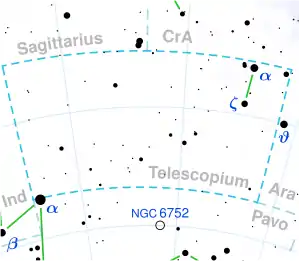HD 192886
HD 192886, also known as HR 7749 or rarely 84 G. Telescopii, is a solitary, yellowish-white hued star located in the southern constellation Telescopium. It has an apparent magnitude of 6.13,[2] making it barely visible to the naked eye, even in ideal conditions. The object is located relatively close at a distance of only 103 light years[1] but is drifting closer with a heliocentric radial velocity of −29.6 km/s.[5] At its current distance, HD 192886's brightness is diminished by 0.13 magnitudes due to extinction from interstellar dust.[16] It has an absolute magnitude of +3.69.[6]
 | |
| Observation data Epoch J2000.0 Equinox J2000.0 (ICRS) | |
|---|---|
| Constellation | Telescopium |
| Right ascension | 20h 19m 17.85169s[1] |
| Declination | −47° 34′ 49.0453″[1] |
| Apparent magnitude (V) | 6.13[2] |
| Characteristics | |
| Spectral type | F5 V[3] or F6 IV-V[4] |
| U−B color index | +0.01[2] |
| B−V color index | +0.46[2] |
| Astrometry | |
| Radial velocity (Rv) | −29.6±0.6[5] km/s |
| Proper motion (μ) | RA: +192.878 mas/yr[1] Dec.: −183.183 mas/yr[1] |
| Parallax (π) | 31.657 ± 0.028 mas[1] |
| Distance | 103.03 ± 0.09 ly (31.59 ± 0.03 pc) |
| Absolute magnitude (MV) | +3.69[6] |
| Details | |
| Mass | 1.32+0.27 −0.16[7] M☉ |
| Radius | 1.39±0.07[8] R☉ |
| Luminosity | 2.92±0.01[1] L☉ |
| Surface gravity (log g) | 4.32[9] cgs |
| Temperature | 6,459±52[10] K |
| Metallicity [Fe/H] | +0.02[11] dex |
| Rotational velocity (v sin i) | 11.6±1.1[12] km/s |
| Age | 2.23[13] Gyr |
| Other designations | |
| Database references | |
| SIMBAD | data |
HD 192886 has a stellar classification of F5 V,[3] making it an ordinary F-type main-sequence star. However, Richard O. Gray and colleagues give it a class of F6 IV-V,[4] indicating that it is slightly cooler and more evolved. It has 1.32 times the mass of the Sun[7] and 1.39 times the Sun's radius.[8] It radiates 2.92 times the luminosity of the Sun[1] from its photosphere at an effective temperature of 6,459 K.[10] It has a solar metallicity ([Fe/H] = +0.02[11]) and is estimated to be 2.23 billion years old.[13] HD 192886 is more likely a main sequence star because it is only 0.24 magnitudes above the main sequence.[17] The star spins modestly with a projected rotational velocity of 11.6 km/s.[12]
References
- Vallenari, A.; et al. (Gaia collaboration) (2023). "Gaia Data Release 3. Summary of the content and survey properties". Astronomy and Astrophysics. 674: A1. arXiv:2208.00211. Bibcode:2023A&A...674A...1G. doi:10.1051/0004-6361/202243940. S2CID 244398875. Gaia DR3 record for this source at VizieR.
- Johnson, H. L.; Mitchell, R. I.; Iriarte, B.; Wisniewski, W. Z. (1966). "UBVRIJKL Photometry of the Bright Stars". Communications of the Lunar and Planetary Laboratory. 4: 99–110. Bibcode:1966CoLPL...4...99J.
- Houk, Nancy (1978). Michigan catalogue of two-dimensional spectral types for the HD stars: Declinations −53° to −40°. Vol. 2. Bibcode:1978mcts.book.....H.
- Gray, R. O.; Corbally, C. J.; Garrison, R. F.; McFadden, M. T.; Bubar, E. J.; McGahee, C. E.; O'Donoghue, A. A.; Knox, E. R. (2 June 2006). "Contributions to the Nearby Stars (NStars) Project: Spectroscopy of Stars Earlier than M0 within 40 pc--The Southern Sample". The Astronomical Journal. 132 (1): 161–170. arXiv:astro-ph/0603770. Bibcode:2006AJ....132..161G. doi:10.1086/504637. eISSN 1538-3881. ISSN 0004-6256.
- Gontcharov, G. A. (November 2006). "Pulkovo Compilation of Radial Velocities for 35,495 Hipparcos stars in a common system". Astronomy Letters. 32 (11): 759–771. arXiv:1606.08053. Bibcode:2006AstL...32..759G. doi:10.1134/S1063773706110065. eISSN 1562-6873. ISSN 1063-7737. S2CID 119231169.
- Anderson, E.; Francis, Ch. (May 2012). "XHIP: An extended hipparcos compilation". Astronomy Letters. 38 (5): 331–346. arXiv:1108.4971. Bibcode:2012AstL...38..331A. doi:10.1134/S1063773712050015. eISSN 1562-6873. ISSN 1063-7737. S2CID 119257644.
- Stassun, Keivan G.; et al. (9 September 2019). "The Revised TESS Input Catalog and Candidate Target List". The Astronomical Journal. 158 (4): 138. arXiv:1905.10694. Bibcode:2019AJ....158..138S. doi:10.3847/1538-3881/ab3467. eISSN 1538-3881. hdl:1721.1/124721. S2CID 166227927.
- Kervella, P.; Thévenin, F.; Di Folco, E.; Ségransan, D. (October 2004). "The angular sizes of dwarf stars and subgiants". Astronomy & Astrophysics. 426 (1): 297–307. arXiv:astro-ph/0404180. Bibcode:2004A&A...426..297K. doi:10.1051/0004-6361:20035930. eISSN 1432-0746. ISSN 0004-6361.
- Netopil, Martin (4 May 2017). "Metallicity calibrations for dwarf stars and giants in the Geneva photometric system". Monthly Notices of the Royal Astronomical Society. 469 (3): 3042–3055. arXiv:1705.00883. Bibcode:2017MNRAS.469.3042N. doi:10.1093/mnras/stx1077. eISSN 1365-2966. ISSN 0035-8711.
- Masana, E.; Jordi, C.; Ribas, I. (10 April 2006). "Effective temperature scale and bolometric corrections from 2MASS photometry". Astronomy & Astrophysics. 450 (2): 735–746. arXiv:astro-ph/0601049. Bibcode:2006A&A...450..735M. doi:10.1051/0004-6361:20054021. eISSN 1432-0746. ISSN 0004-6361.
- Casagrande, L.; Schönrich, R.; Asplund, M.; Cassisi, S.; Ramírez, I.; Meléndez, J.; Bensby, T.; Feltzing, S. (26 May 2011). "New constraints on the chemical evolution of the solar neighbourhood and Galactic disc(s): Improved astrophysical parameters for the Geneva-Copenhagen Survey⋆". Astronomy & Astrophysics. 530: A138. arXiv:1103.4651. Bibcode:2011A&A...530A.138C. doi:10.1051/0004-6361/201016276. eISSN 1432-0746. ISSN 0004-6361.
- Groot, P. J.; Piters, A. J. M.; Paradijs, van (September 1996). "Rotational velocities of F dwarfs; application of the Fourier-Bessel transformation method". Astronomy and Astrophysics Supplement Series. 118 (3): 545–555. Bibcode:1996A&AS..118..545G. doi:10.1051/aas:1996214. ISSN 0365-0138.
- Ibukiyama, A.; Arimoto, N. (21 October 2002). "HIPPARCOS age-metallicity relation of the solar neighbourhood disc stars". Astronomy & Astrophysics. 394 (3): 927–941. arXiv:astro-ph/0207108. Bibcode:2002A&A...394..927I. doi:10.1051/0004-6361:20021157. eISSN 1432-0746. ISSN 0004-6361.
- Gould, Benjamin Apthorp (1878). "Uranometria Argentina : brillantez y posicion de las estrellas fijas, hasta la septima magnitud, comprendidas dentro de cien grados del polo austral : con atlas". Resultados del Observatorio Nacional Argentino. 1. Bibcode:1879RNAO....1.....G.
- "HD 192886". SIMBAD. Centre de données astronomiques de Strasbourg. Retrieved 7 February 2023.
- Gontcharov, George A.; Mosenkov, Aleksandr V. (28 September 2017). "Verifying reddening and extinction for Gaia DR1 TGAS main sequence stars". Monthly Notices of the Royal Astronomical Society. 472 (4): 3805–3820. arXiv:1709.01160. Bibcode:2017MNRAS.472.3805G. doi:10.1093/mnras/stx2219. eISSN 1365-2966. ISSN 0035-8711.
- Nordström, B.; Mayor, M.; Andersen, J.; Holmberg, J.; Pont, F.; Jørgensen, B. R.; Olsen, E. H.; Udry, S.; Mowlavi, N. (16 April 2004). "The Geneva-Copenhagen survey of the Solar neighbourhood". Astronomy & Astrophysics. 418 (3): 989–1019. arXiv:astro-ph/0405198. Bibcode:2004A&A...418..989N. doi:10.1051/0004-6361:20035959. eISSN 1432-0746. ISSN 0004-6361.